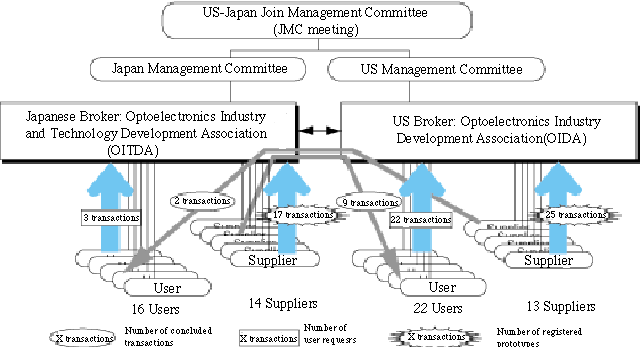 Goal of the Project
Goal of the Project  Goal of the Project
Goal of the Project
The JOP (US-Japan Joint Optoelectronics Project) is geared towards joint research and development of leading-edge optical devices which are indispensable for the evolution of information processing technologies under the political framework of the U.S.-Japan Global Partnership Agreement.

Fig.1: Structure and the Current Status of JOP(as June 19,1887)
As illustrated in Fig. 1, we employed intermediary organizations referred to as "brokers" both in the United States and Japan to facilitate the acquisition of innovative optical device prototypes which have otherwise been unavailable and inaccessible to users.
The Optoelectronics Industry and Technology Development Association (OITDA) serves as the Japanese Broker and the Optoelectronics Industry Development Association (OIDA) is the US counterpart.
 Duration and Management
Duration and Management
Based on the US-Japan Joint Optoelectronics Project Implementation Plan agreed upon by the two countries on April 25, 1994, a two-year trial project started from February 1, 1995. At the 4th meeting of the US-Japan Joint Management Committee (JMC) held on April 30, 1996, it was concluded that the trial phase "should be extended for another year until March 31, 1998, in order to make a more exact evaluation of the plan."
JMC members further discussed how to develop the project for the remaining period after April 1998 at the 5th JMC meeting on October 31, 1996. At the meeting, they agreed that the basic policy would be that "the JOP should be continued until 2001 when the Project for the Fundamental Information Technology of the Next Generation will be completed, if this scheme is evaluated as a success based upon the three-year trial phase." A specific method and procedure for evaluation were left for the agenda of the 6th JMC meeting in July 1997.
As stated above, the direction and operation of the JOP were discussed at a meeting of the Joint Management Committee consisting of five members from each country.
This project, including the operating expenses of the brokers from U.S. and Japan, are financed by a consignment fee from MITI (RWCP).
 Current Activities
Current Activities
As shown in Fig. 1, eleven transactions were successfully concluded as of June 10, 1997. Out of the 11 cases, nine were contracted between Japanese suppliers and US users and the remaining two were agreed upon by US suppliers and Japanese users.
In this project, users are allowed to register their requests about the type and specifications of prototypes to their respective brokers in advance; the US and Japanese brokers now have a total of 25 user requests. On the other hand, US and Japanese suppliers have enrolled 42 prototypes which are ready to be provided to users.
Prototypes offered by suppliers, and requests made by users are getting richer both in variety and number, suggesting that the JOP is making a great contribution to research and development activities.
In addition to JMC meetings, the US and Japanese brokers convened two broker meetings in 1996 to discuss some important and pending matters. Also, the brokers hosted two types of workshops; a JOP Workshop for the general people, and an Expert Workshop for specialists to discuss the policy of their activities.
Taking the opportunity at OC '96 in Sendai, Miyagi Prefecture, a JOP Workshop was held on April 25, 1996, and an Expert Workshop for US and Japanese specialists was convened on the following day. On July 16, a JOP Workshop was held as part of the InterOpto '96 in Makuhari, Chiba Prefecture. The 2nd Expert Workshop opened at MPPOI '96 in Maui, Hawaii, just before the 6th JMC meeting.
Thanks to these positive activities, 11 users and four suppliers recently joined the project both in the United States and Japan in FY 1996. Ten out of eleven concluded transactions have been made in FY 1996.
 Future Development of JOP
Future Development of JOP
Based on the US-Japan Joint Optoelectronics Project Implementation Plan, US users of this scheme are funded under the support of NSF and DARPA. As a result, a number of US users have registered in this scheme. We are now in preparation of a similar financial system in accordance with the US-Japan Joint Optoelectronics Project Implementation Plan here in Japan.
Not more than a year remains for the trial phase which started in February 1995. We have not yet decided on how to promote the project after the trial phase ends in 1998. "If this scheme is evaluated as a success because of the three-year trial phase," JMC will discuss the future development of the project in order to make it more accessible for users and suppliers, including the reconsideration of the US-Japan Joint Optoelectronics Project Implementation Plan.